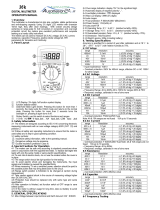
DVM345DI GB
4
4.3. Resistance Measurements
1. Connect the black test lead to the "COM"-jack and the red test lead to the "V/ -jack. The
polarity of the red test lead is positive (+).
2. 3ODFHWKHIXQFWLRQVZLWFKLQWKH -range to be used and connect the test leads to the
resistance you wish to measure.
NOTE :
v The device may need a few seconds to produce a stable reading when measuring
UHVLVWDQFHVLQH[FHVVRI0 7KLVLVHQWLUHO\QRUPDO
v The message "OL" and the full bar graph will be displayed if the input is not connected, e.g.
with an open circuit.
v Disconnect the circuit to be tested and make sure that all capacitors have been fully
discharged before measuring the in-circuit resistance.
4.4. Capacitance Measurements
1. Place the function switch in the "nF"-position.
2. Make sure that the capacitor has been fully discharged prior to connecting the capacitor to
the capacitance socket.
WARNING :
Disconnect all test leads from the circuit to be tested before inserting the capacitor in the
capacitance socket. Make sure that no components are connected to this socket when
performing voltage measurements with test leads.
4.5. Temperature Measurements
1. Place the function switch in the "TEMP"-position.
2. Connect the "K"-type thermocouple with the temperature socket on the front panel and
contact the object in question with the thermocouple.
WARNING :
Remove the thermocouple before selecting a different function in order to avoid electroshocks.
Do not connect the thermocouple to the "TEMP"-socket unless all test leads have been
disconnected from the circuits you wish to test.
4.6. Audible Continuity Test
1. Connect the black test lead to the "COM"-jack and the red test lead to the 9 -jack. The
polarity of the red test lead is positive (+).
2. Place the function switch in the " "-position and push the " "-button on the front panel.
3. Connect the test leads with two points of the circuit you wish to test. The built-in buzzer will
sound if continuity exists (for resistances < 30








